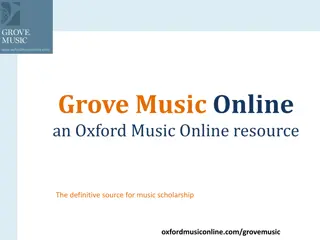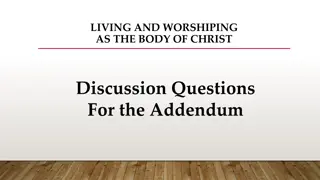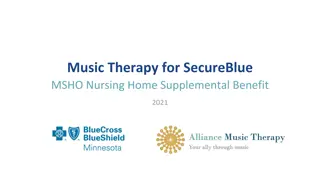Victorian Curriculum in the Arts: An Overview
Explore the Victorian Curriculum framework for Instrumental Music and its integration with the Arts disciplines such as Dance, Drama, Media Arts, Music, Visual Arts, and Visual Communication Design. The curriculum provides a structured approach for teaching and learning across different year levels, emphasizing critical and creative thinking skills. Learn about the continuum of learning areas and capabilities, as well as the curriculum planning considerations for schools transitioning from AusVELS or the Australian Curriculum.
Download Presentation

Please find below an Image/Link to download the presentation.
The content on the website is provided AS IS for your information and personal use only. It may not be sold, licensed, or shared on other websites without obtaining consent from the author.If you encounter any issues during the download, it is possible that the publisher has removed the file from their server.
You are allowed to download the files provided on this website for personal or commercial use, subject to the condition that they are used lawfully. All files are the property of their respective owners.
The content on the website is provided AS IS for your information and personal use only. It may not be sold, licensed, or shared on other websites without obtaining consent from the author.
E N D
Presentation Transcript
Introducing Victorian Curriculum The Arts Instrumental Music
Session overview The Arts in the Victorian Curriculum Learning area structure Organising ideas Transition from AusVELS or Australian Curriculum Working with the curriculum Curriculum planning for Arts learning Whole school, learning area, year level, units/sequences of learning Partnerships, incursions, excursions and residencies Discipline overview: Dance, Drama, Media Arts, Music, Visual Arts & Visual Communication Design Key terms and phrases Range of Viewpoints
Victorian Curriculum F10 Released in September 2015 as a central component of the Education State Provides a stable foundation for the development and implementation of whole-school teaching and learning programs Victorian Curriculum F 10 incorporates the Australian Curriculum and reflects Victorian priorities and standards
Victorian Curriculum Learning Areas Capabilities The Arts Dance Drama Media Arts Music Visual Arts Visual Communication Design Critical and Creative Thinking Victorian Curriculum F-10 is represented as a continuum of learning Ethical Intercultural Personal and Social English Health and Physical Education The Humanities History Geography Civics and Citizenship Business and Economics Languages Mathematics Science Technologies Design and Technologies Digital Technologies
Take the web tour Overview Introduction Using the view and filter options
The Arts in Victorian Curriculum One Learning Area that includes curriculum for six Arts disciplines that schools use to plan and deliver a teaching and learning program: F 10 Dance Drama Media Arts Music Visual Arts 7 10 Visual Communication Design
The Arts Curriculum F 1-2 3-4 5-6 7-8 9-10 The curriculum is represented on a continuum across 6 levels of achievement An achievement standard is provided for each band The Foundation (F) standard signifies the importance of The Arts in the early years of schooling A curriculum to support students with a disability is provided and this is know as Towards Foundation Levels A-D
Level v Year the curriculum should be regarded as a developmental continuum or progression of learning schools and teachers are best placed to decide where on the continuum the focus of a learning program for a particular Arts discipline or a group of students should be positioned
Victorian Curriculum: The Arts Strands: explore & express/represent ideas practices present & perform respond & interpret 2 + Organising ideas: students learn as artist and as audience Students learn by making & responding
Whats happening now? Where is learning through an instrumental music program positioned in the whole-school plan Stand alone Connected to classroom music Integral part of whole school events or projects Connected to community music-making?
Common strand structure The curriculum for each of the Arts disciplines uses a common structure with four interdependent strands, each involving making and responding This structure provides flexibility for schools to develop learning programs that Are continuous or non- continuous within a single discipline Connect across learning areas or Arts disciplines Explore and Express Ideas Present and Perform Practices Respond and Interpret
Learning in: Music Music practices listening, composing and performing used separately and in combination supported by additional activities Using notation and ICT to record and communicate musical ideas; reading, writing and interpreting developing skills and techniques to discuss their own music and the music and music practices of others. The elements of music Musical ideas are conceived, organised and shaped by aspects and combinations of Rhythm, Pitch, Dynamics and expression, Form and structure, Timbre/tone colour & Texture.
Learning in Music Strand Explore and Express Ideas Music Practices Present and Perform Respond and Interpret planning, rehearsing and refining performances to communicate ideas and intentions to an audience voice, instruments, technologies exploring sound and silence and ways of using voice, body percussion, instruments and technologies develop and express ideas listening skills skills, techniques and processes for listening, composing and performing music from diverse cultures, times and locations reflecting, questioning, analysing and evaluating as listeners, composers and performers listening skills to discriminate, identify http://victoriancurriculum.vcaa.vic.edu.au/the-arts/music/introduction/structure and imagination
Learning as artist and audience Artwork Artist Audience responding and interpreting using imagination expressing/representing ideas presenting and performing techniques & processes using materials practicing skills instruments evaluation exploring thinking analysis media
Learning as artist and audience in Music performer composer listener singing, playing, composing, improvising, arranging, interpreting, developing skills & techniques, notating, recording, performing, reflecting, analysing, evaluating
Learning by making & responding making is informed by responding & responding informs making students learn as artist and as audience through making and responding
Victorian Curriculum: The Arts - Music Assumptions the curriculum will be used in many different learning contexts; how that happens will be decided by schools and teachers the same content is relevant across instrumental, classroom, ensemble and informal contexts the curriculum is not designed for use with any particular pedagogy or program each student s progress on the music learning continuum mapped by the curriculum should reflect their achievements across learning contexts Opportunities to use digital technologies are embedded throughout the curriculum
Guidelines for including the Arts in a whole-school curriculum plan F-2 At the Foundation stage (Prep Year 2), schools focus on five curriculum areas: English, Mathematics, The Arts, Health and Physical Education and Personal and Social Capability . (p. 19). At these levels, substantial attention should be paid to the Arts. 3-8 an Arts program that in Years 3 4 includes all five Arts disciplines and at Years 5 6 and 7 8 consists of at least two Arts disciplines, one from the Performing Arts and one from the Visual Arts. (p. 20) 9-10
Developing Arts teaching and learning programs The common strand structure for each of the Arts discipline-specific curricula allows schools to continue to deliver The Arts through learning programs that focus on one or more arts disciplines, for example, a junior secondary program where students complete a semester of learning in each Arts discipline over 2 years a performing arts program with dance, drama and music components a visual arts program that focuses on 2-d, 3-d and 4d forms a literacy program that draws on curriculum from English and Media Arts instrumental music Project-based learning where Arts learning is aligned to themes, other learning areas or capabilities or inquiry questions, for example work developed in other learning areas where an Arts form (film, play, song, dance) is used to communicate knowledge and understanding work developed with an artist-in-residence (physcially or virtually) or local artist /s or arts organisation a celebration of school and community and identity expressed through dance, drama, media arts, music and visual arts presentations and performances created by the students in consultation with local Koorie elders and members of the community
Terminology Band/Level descriptions statements that provide an overview to the content descriptions and achievement standard within the level or band. Strands key organising elements within each curriculum area. Content descriptions specific and discrete information identifying what teachers are expected to teach and students are expected to learn. Elaborations non-mandated, advisory examples that provide guidance on how the curriculum may be transformed into a classroom activity or learning opportunity. Achievement standards statements that describe what students are typically able to understand, and are the basis for reporting student achievement.
Music: Explore & express ideas Foundation L 1 & 2 L 3 & 4 L5 & 6 L7 & 8 L9 & 10 Explore sound and silence and ways of using their voices, movement and instruments to express ideas Use imagination and experimentation to explore musical ideas using voice, movement, instruments and body percussion Use imagination and creativity to explore pitch, rhythm/time and form, dynamics and tempo using voice, movement and instruments Explore ways of combining the elements of music using listening skills, voice and a range of instruments, objects and electronically generated sounds to create effects Experiment with elements of music, in isolation and in combination, using listening skills, voice, instruments and technologies to find ways to create and manipulate effects. Improvise and arrange music, using aural awareness and technical skills to manipulate the elements of music to explore options for interpretation and developing music ideas Develop music ideas through improvisation, composition and performance, combining and manipulating the elements of music Manipulate combinations of the elements of music in a range of styles, using technology and notation to communicate music ideas and intentions
Achievement Standards Based on the content descriptions Include details that inform assessment task design Nominally represent expectations over a 2 year period For example: By the end of Level 8, students manipulate the elements of music and stylistic conventions to improvise, compose and perform music. use evidence from listening and analysis to interpret, rehearse and perform songs and instrumental pieces in unison and in parts, demonstrate technical and expressive skills. use music terminology and symbols to recognise, describe and notate selected features of music identify and analyse how the elements of music are used in different styles and apply this knowledge in their performances and compositions evaluate musical choices they and others have made to communicate ideas and intentions as performers and composers of music from different cultures, times and locations.
Curriculum mapping Mapping identifies the extent of curriculum coverage in units of work and clearly links teaching, learning and assessment while working with the curriculum continuum. Mapping templates support teachers to identify where content descriptions and achievement standards are being explicitly addressed within the school s teaching and learning program. Instructions: http://www.vcaa.vic.edu.au/Pages/foundation10/ viccurriculum/curriculumplanning.aspx Templates For each Arts discipline F-6 7-10
Making choices about teaching materials No specific materials or stimulus is stipulated in The Arts curriculum When the curriculum mentions across a range of styles, forms etc. teachers have the opportunity to choose teaching resources or stimulus materials that are relevant for their students. For example, teachers can make choices to ensure students experience Arts practices typical of cultures that students identify with that reflect the culture practiced by the indigenous people of the Country on which the school in situated, in consultation with the local Koorie, Aboriginal or Torres Strait Islander community used by artists and arts organisations in the local community typical of selected styles or practitioners relevant to particular forms or ways of working
Curriculum and resources Curriculum 2016 school choice between AusVELS and Victoria Curriculum F 10 Victorian Curriculum F 10 from 2017 Resources General advice Specific Arts discipline advice Evolving Bookmark and check for updates Email ideas for updates http://www.vcaa.vic.edu.au/Pages/foundation10/f10index.aspx
Education State goals, ambitions and targets Discuss the opportunities provided by the Education State target for The Arts Page 11: http://www.education.vic.gov.au/Documents/about/educationstate/launch.pdf
Contacts Curriculum Manager: Performing Arts Helen Champion PH: 9032 1723 Email: champion.helen.h@edumail.vic.gov.au























